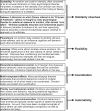How should neuroscience study emotions? by distinguishing emotion states, concepts, and experiences
- PMID: 27798256
- PMCID: PMC5390692
- DOI: 10.1093/scan/nsw153
How should neuroscience study emotions? by distinguishing emotion states, concepts, and experiences
Abstract
In this debate with Lisa Feldman Barrett, I defend a view of emotions as biological functional states. Affective neuroscience studies emotions in this sense, but it also studies the conscious experience of emotion ('feelings'), our ability to attribute emotions to others and to animals ('attribution', 'anthropomorphizing'), our ability to think and talk about emotion ('concepts of emotion', 'semantic knowledge of emotion') and the behaviors caused by an emotion ('expression of emotions', 'emotional reactions'). I think that the most pressing challenge facing affective neuroscience is the need to carefully distinguish between these distinct aspects of 'emotion'. I view emotion states as evolved functional states that regulate complex behavior, in both people and animals, in response to challenges that instantiate recurrent environmental themes. These functional states, in turn, can also cause conscious experiences (feelings), and their effects and our memories for those effects also contribute to our semantic knowledge of emotions (concepts). Cross-species studies, dissociations in neurological and psychiatric patients, and more ecologically valid neuroimaging designs should be used to partly separate these different phenomena.
Keywords: affective neuroscience; amygdala; concepts; emotion; feelings.
© The Author (2016). Published by Oxford University Press.
Figures


Comment in
-
Functionalism cannot save the classical view of emotion.Soc Cogn Affect Neurosci. 2017 Jan 1;12(1):34-36. doi: 10.1093/scan/nsw156. Soc Cogn Affect Neurosci. 2017. PMID: 27798259 Free PMC article. No abstract available.
References
-
- Darwin C. (1872/1965). The Expression of the Emotions in Man and Animals. Chicago: University of Chicago Press.
-
- Scherer K.R. (1994). Emotions serve to decouple stimulus and response In: Ekman P., Davidson R.J., editors. The Nature of Emotion, pp. 127–30. New York: Oxford University Press.
-
- Adolphs R. (in press). Emotions are functional states that cause feelings and behavior In: Davidson R.J., Shackman A., Fox A., Lapate R., editors. The Nature of Emotion, 2nd edn New York: Oxford University Press.
-
- Lazarus R.S. (1991). Emotion and Adaptation. New York: Oxford University Press.
MeSH terms
Grants and funding
LinkOut - more resources
Full Text Sources
Other Literature Sources

